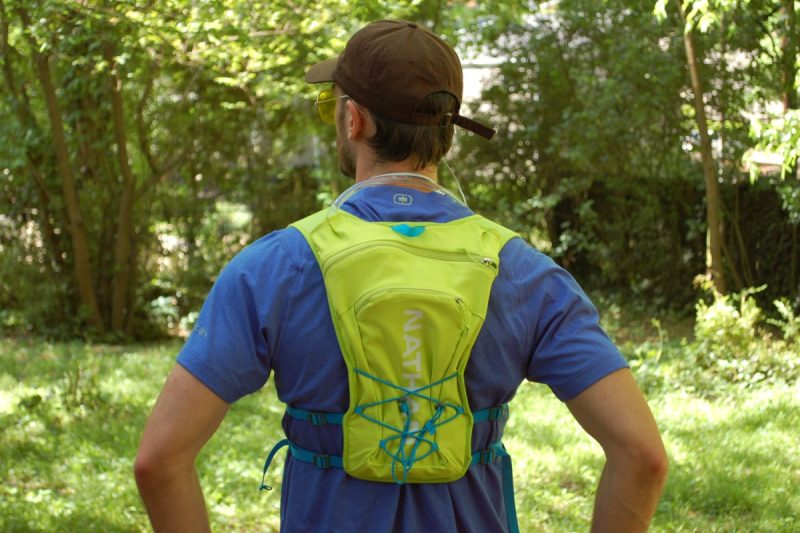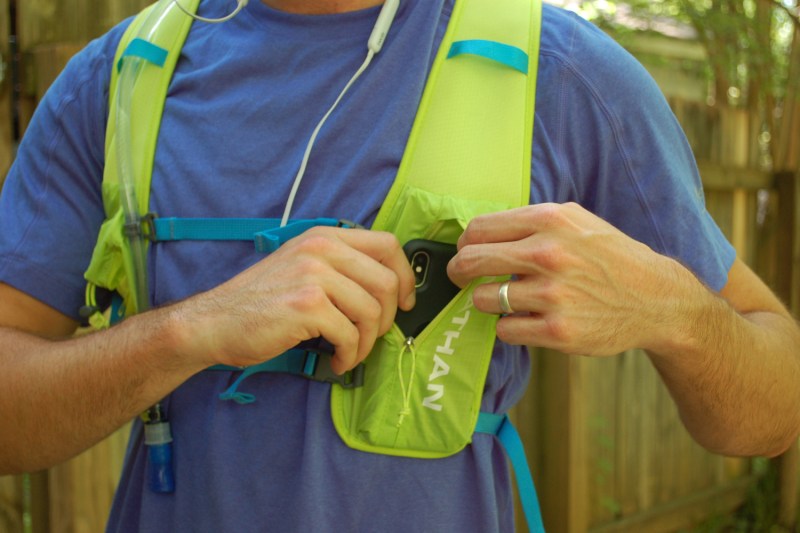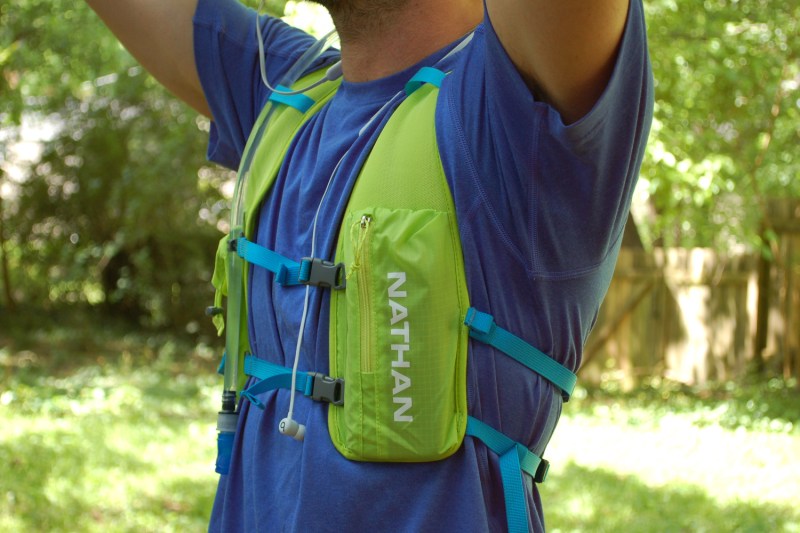As any seasoned runner will tell you, you won’t get far on foot if you’re not staying properly hydrated. Keeping fluids in your body lets you run further and faster, and also makes it easier for your body to recover after a long haul. Hydration presents a particularly tough problem for trail runners, who often go miles at a time without access to a clean water source. Combine that with the need to haul a few extra odds and ends like snacks, protective clothing, and emergency supplies, and you’ll start to see the trail runner’s dilemma. Solving that dilemma is where running packs like the Nathan Quickstart 2.0 6L come into play.
I’ve been out running for the past month with the new Nathan Quickstart 2.o 6L everywhere from my neighborhood sidewalks to backcountry hiking trails to see how it performs in real-world conditions. It’s a versatile pack for runners of just about any discipline and solves both the hydration problem and the gear storage problem in a wide range of applications.

What Is the Nathan Quickstart 2.0 6L Hydration Pack?
The Nathan Quickstart 2.0 6L hydration pack is essentially a superlight running vest with a 1.5-liter hydration bladder and six liters of gear storage added in the mix. The Quickstart combines highly breathable and moisture-wicking fabrics with a flexible fitment system to create a snug and secure fitting pack that doesn’t weigh you down or bounce around while you run.
How Does the Nathan Quickstart 2.0 6L Hydration Pack Work?
The Nathan Quickstart works by combining the features of a runner’s hydration vest with a minimalist ultralight backpack. Six liters of storage capacity means you’ve got room for all the usual trail running essentials like snacks, a rain jacket, and emergency supplies, but the lightweight and breathable construction of the vest won’t weigh you down or chafe your skin as you move throughout the day.

Features Of the Nathan Quickstart 2.0 6L
- 6 liters of storage capacity
- 1.5-liter hydration bladder included
- Two separate rear zipper pockets
- Two front storage pockets
- 360-degree reflective detail for low light visibility
- Moisture-wicking and chafe-free fabric construction
- Adjustable sternum straps
- Adjustable shock cord compression system
What I Like About the Nathan Quickstart 2.0 6L
Fit and Comfort
One of my favorite aspects of the Quickstart 2.0 is its all-around comfort. The entire pack is made from extremely lightweight and breathable materials, and I particularly like that all of the surfaces that make direct contact with your body are made from a lightly cushioned mesh. This keeps the pack from feeling overly cumbersome, even when you’ve got it loaded down with a full hydration bladder, a phone, snacks, etc.
The adjustment strap system also adds a great deal to the overall comfort of the pack. Nathan uses dual adjustment straps on each side of the pack, which are attached to the pack itself with rugged elastic hoops. This flexible strap system allowed me to cinch the pack down securely to my body, but still offers a little “give” so the pack doesn’t feel overly tight when you’re breathing heavily.

Storage
I’m the type that likes to bring extra snacks and gear along for a run, which is what made the comparatively generous 6L size so attractive. The two zippered pockets at the rear give you plenty of room for snacks, drink mixes, and an extra packable layer, even with the full 1.5 liters of water factored into the mix.
The two front pockets are another highlight here in terms of storage. Nathan put a secure zippered pocket on the left strap of the pack, which is the perfect size for holding your phone without having it move around constantly. On the right shoulder there’s a double mesh pocket with an elastic shock cord which is perfect for stashing an extra water bottle and other small items. I particularly like this feature combined with the hydration pack because it allowed me to extend my range, and also gave me a separate place to store an electrolyte-enhanced bottle of water separate from my main supply.
What I Don’t Like About the Nathan Quickstart 2.o 6L
It Can Be Noisy.
If you’ve never run with a hydration bladder before, the noise factor is a little shocking when you first start out. I got used to the sound and feel of water sloshing around in the bladder after a few runs with the Quickstart 2.0, but it was a little annoying at first. Removing any extra air space in the bladder helps quieten it down a bit, but I was never able to silence it completely. Pro tip: Blasting music through your wireless headphones of choice completely (where appropriate) solves this issue.
Dialing in the Fit Takes Some Work
Although I consider the highly-customizable fit of the Nathan Quickstart 2.0 a highlight of the pack, all those straps take some time to dial in. This pack uses six straps in total, with two on each side of the body and two more at the sternum. That’s a lot of tightening and adjusting to dial in a secure-yet-comfortable fit, and if you’re on the slimmer side like myself it takes some time to get all that extra strap-age stashed and tucked away as well.
FAQs for the Nathan Quickstart 2.o 6L
Whether you’re coming from the world or lumbar packs or simple handheld bottles for your on-the-go hydration, chances are you’ve got a few questions about the Nathan Quickstart 2.0 6L. Here are some of the most common questions I could find to test in the field.
How Much Water Should I Bring for My Run?
You should be drinking about 5-10 ounces every 20 minutes, or up to 30 ounces an hour. The Nathan Quickstart 2.0 comes with a 1.5 L hydration bladder, so it’s ideal for about two hours of sustained trail running without stopping to refill. If you’re planning on running for over two hours, you should plan on either utilizing the extra water bottle pocket, or having a refill location planned into your route ahead of time.
How Should I Pack the Nathan Quickstart 2.o 6L for Trail Running?
You’ll want to start by filling up your water bladder first, since it’s always a pain trying to take those in and out of a pack that’s already loaded down. After that, put items that you’re less likely to use at the bottom (first aid kit, rain jacket, etc), and then your quick access/high-use items like snacks and drink mixes at the top.
Should You Buy the Nathan Quickstart 2.o 6L?
All things considered, I’m a fan of the Nathan Quickstart 2.o 6L, and if you’re curious about trying a hydration pack on your runs, this is a great one to try. Six liters of storage capacity is great on longer runs when you need it, but the bungee compression system on the back keeps everything tight and secure when you don’t. That makes the 6L version an incredibly versatile “all in one” solution for trail runners, and the extra water bottle pocket boosts that versatility even further as a minimalist hydration option for shorter runs or as a range extender for longer treks.




